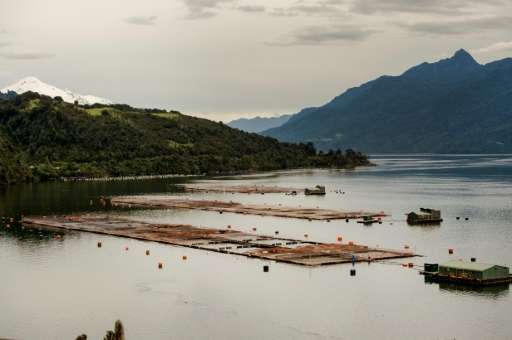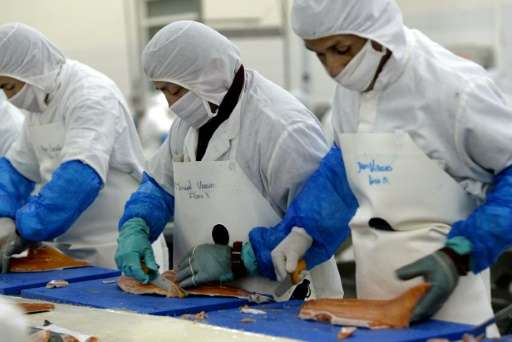A sea-water salmon farm on Tagua Tagua lake, Puerto Montt, in southern Chile: environmental groups warn the industry has grown so big in Chile as to be unsustainable
Salmon are leaping in their millions from Chilean fish farms to US, Japanese and European dining tables—but surging demand and environmental concerns have Chile wriggling on the hook.
The world's second-biggest producer of the juicy pink fish after Norway, Chile earned $3.8 billion from farmed salmon last year—but campaigners warn the environment is paying a high cost.
"The demand for salmon is unsustainable," says Liesbeth van der Meer, director of environmental group Oceana Chile.
"There is an ecological burden that the system can no longer endure. Beyond a certain quantity of salmon, it collapses."
She calculates that for every 190 grams of salmon produced, a kilo of local fish is used to feed the farmed salmon.
To make the industry sustainable, Chile should halve its current salmon production, she says.
Yet the industry estimates that demand for salmon is rising by 10 percent a year.
And 70,000 jobs in Chile depend on it.
Killer algae
Last year, red algae infested the waters off southern Chile, killing other sea life. Environmentalists blamed it on waste emissions from fish farms.
The algae wiped out a fifth of Chile's salmon production in 2016.
It fell from 883,000 to 728,000 tonnes—most of that exported to the United States, Europe, Brazil and Japan.
Chile's size in the market is such that the fall contributed to a 40-percent rise in world salmon prices.
An outbreak of red algae wiped out a fifth of Chile's salmon production for 2016, causing a 40 percent spike in salmon prices worldwide
Producers are recovering from that blow. But the president of the SalmonChile trade association, Felipe Sandoval, acknowledges they are having to "think and take steps to ensure medium- and long-term stability" and reduce costs.
Separately, the industry has been criticized for pumping antibiotics into the salmon, prompting warnings that this could promote drug-resistant super-bacteria.
In 2016 the Chilean salmon industry used 382.5 tonnes of antibiotics.
That was 700 times the amount used in Norway.
Jobs and growth
The government in 2007 had to reduce the intensity of salmon farming due to an outbreak of infection.
Any further health alerts will hit production, warned Eugenio Zamorano, head of aquaculture in the fisheries ministry.
But "if the health and environmental parameters are working, the industry can grow," he told AFP.
New regulations affecting the fish farms will come into force in 2018 in response to weather phenomena in the Pacific that experts suspect are due to climate change.
Compared to Chile's two other major salmon-producing regions, Magallanes—the furthest to the south—has a relatively good level of environmental controls, without too many fish farms close together, the government says.
With cooler waters, farms in Magallanes use less than one percent of the antibiotics used in the other two regions, Aysen and Los Lagos.
"Magallanes offers a possibility for sustainable development" in salmon farming, said Zamorano.
The government's aim, he says, is "to generate sustainable development of an economic activity that generates jobs and revenues."
© 2017 AFP
























